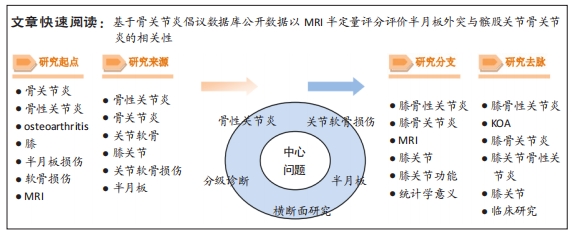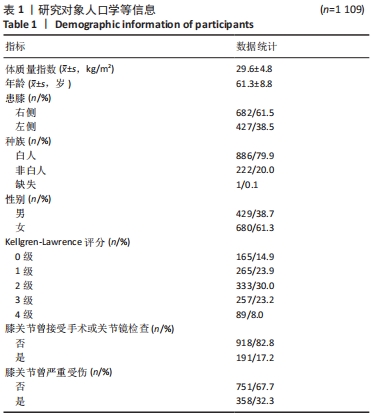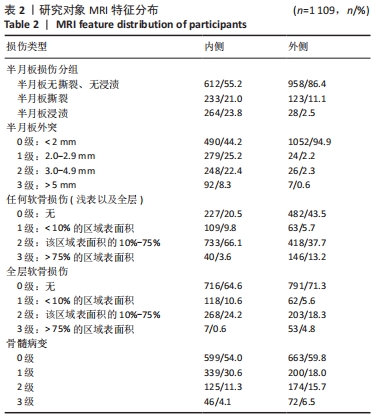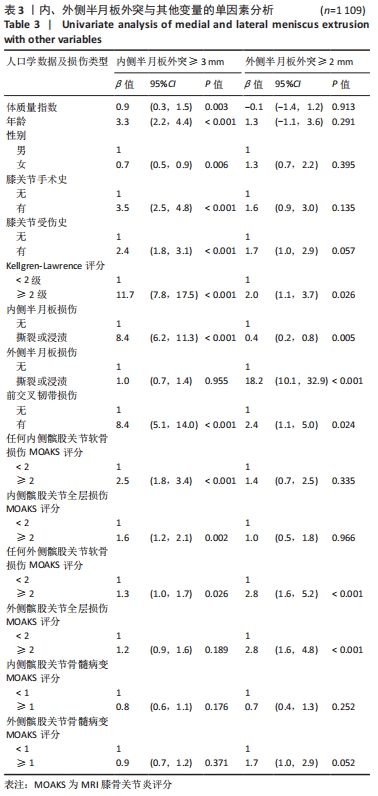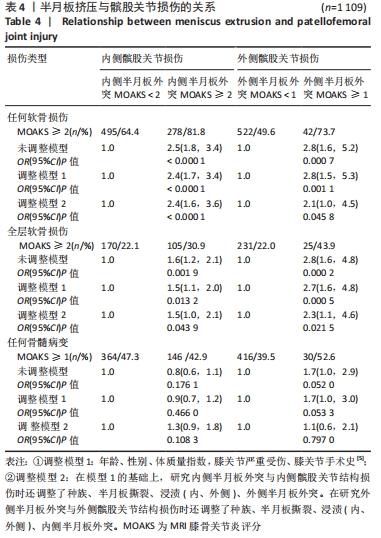[1] SHARMA L. Osteoarthritis of the Knee. N Engl J Med. 2021;384(1):51-59.
[2] ENGLUND M, ROEMER FW, HAYASHI D, et al. Meniscus pathology, osteoarthritis and the treatment controversy. Nat Rev Rheumatol. 2012;8(7):412-419.
[3] POULSEN E, GONCALVES GH, BRICCA A, et al. Knee osteoarthritis risk is increased 4-6 fold after knee injury - a systematic review and meta-analysis. Br J Sports Med. 2019;53(23):1454-1463.
[4] 国家老年疾病临床医学研究中心(湘雅医院),中华医学会骨科学分会关节外科学组.中国髌股关节骨关节炎诊疗指南(2020年版)[J].中华骨科杂志,2020,40(18):1227-1234.
[5] HART HF, CROSSLEY KM, FELSON D, et al. Relation of meniscus pathology to prevalence and worsening of patellofemoral joint osteoarthritis: the Multicenter Osteoarthritis Study. Osteoarthritis Cartilage. 2018;26(7):912-919.
[6] ANTONY B, DRIBAN JB, PRICE LL, et al. The relationship between meniscal pathology and osteoarthritis depends on the type of meniscal damage visible on magnetic resonance images: data from the Osteoarthritis Initiative. Osteoarthritis Cartilage. 2017;25(1):76-84.
[7] CHIBA D, SASAKI E, OTA S, et al. US detection of medial meniscus extrusion can predict the risk of developing radiographic knee osteoarthritis: a 5-year cohort study. Eur Radiol. 2020;30(7):3996-4004.
[8] SWAMY N, WADHWA V, BAJAJ G, et al. Medial meniscal extrusion: Detection, evaluation and clinical implications. Eur J Radiol. 2018;102: 115-124.
[9] EVERHART JS, MAGNUSSEN RA, ABOULJOUD MM, et al. Meniscus tears accelerate joint space loss and lateral meniscal extrusion increases risk of knee arthroplasty in middle-aged adults. J Orthop Res. 2020;38(11):2495-2504.
[10] LIU Y, DU G, LI X. Threshold for lateral meniscal body extrusion on MRI in middle-aged and elderly patients with symptomatic knee osteoarthritis. Diagn Interv Imaging. 2020;101(10):677-683.
[11] LANKHORST NE, DAMEN J, OEI EH, et al. Incidence, prevalence, natural course and prognosis of patellofemoral osteoarthritis: the Cohort Hip and Cohort Knee study. Osteoarthritis Cartilage. 2017;25(5):647-653.
[12] KOBAYASHI S, PAPPAS E, FRANSEN M, et al. The prevalence of patellofemoral osteoarthritis: a systematic review and meta-analysis. Osteoarthritis Cartilage. 2016;24(10):1697-1707.
[13] HART HF, STEFANIK JJ, WYNDOW N, et al. The prevalence of radiographic and MRI-defined patellofemoral osteoarthritis and structural pathology: a systematic review and meta-analysis. Br J Sports Med. 2017;51(16):1195-1208.
[14] LI Z, LIU Q, ZHAO C, et al. High prevalence of patellofemoral osteoarthritis in China: a multi-center population-based osteoarthritis study. Clin Rheumatol. 2020;39(12):3615-3623.
[15] PETERFY CG, SCHNEIDER E, NEVITT M. The osteoarthritis initiative: report on the design rationale for the magnetic resonance imaging protocol for the knee. Osteoarthritis Cartilage. 2008;16(12):1433-1441.
[16] HUNTER DJ, GUERMAZI A, LO GH, et al. Evolution of semi-quantitative whole joint assessment of knee OA: MOAKS (MRI Osteoarthritis Knee Score). Osteoarthritis Cartilage. 2011;19(8):990-1002.
[17] COLLINS JE, LOSINA E, NEVITT MC, et al. Semiquantitative Imaging Biomarkers of Knee Osteoarthritis Progression: Data From the Foundation for the National Institutes of Health Osteoarthritis Biomarkers Consortium. Arthritis Rheumatol. 2016;68(10):2422-2431.
[18] 刘新光,丁冉,刘晨,等.内侧半月板半脱位的相关因素分析[J].中国矫形外科杂志,2021,29(6):503-506.
[19] KOHN MD, SASSOON AA, FERNANDO ND. Classifications in Brief: Kellgren-Lawrence Classification of Osteoarthritis. Clin Orthop Relat Res. 2016;474(8):1886-1893.
[20] STEFANIK JJ, GUERMAZI A, ROEMER FW, et al. Changes in patellofemoral and tibiofemoral joint cartilage damage and bone marrow lesions over 7 years: the Multicenter Osteoarthritis Study. Osteoarthritis Cartilage. 2016;24(7):1160-1166.
[21] STEFANIK JJ, NIU J, GROSS KD, et al. Using magnetic resonance imaging to determine the compartmental prevalence of knee joint structural damage. Osteoarthritis Cartilage. 2013;21(5):695-699.
[22] TREPCZYNSKI A, KUTZNER I, KORNAROPOULOS E, et al. Patellofemoral joint contact forces during activities with high knee flexion. J Orthop Res. 2012;30(3):408-415.
[23] 雷光华.髌股关节骨关节炎的诊疗现状[J].医学临床研究,2020, 37(5):641-645.
[24] BLOECKER K, WIRTH W, GUERMAZI A, et al. Longitudinal change in quantitative meniscus measurements in knee osteoarthritis--data from the Osteoarthritis Initiative. Eur Radiol. 2015;25(10):2960-2968.
[25] LEE TQ, MORRIS G, CSINTALAN RP. The influence of tibial and femoral rotation on patellofemoral contact area and pressure. J Orthop Sports Phys Ther. 2003;33(11):686-693.
[26] COLLINS NJ, BARTON CJ, VAN MIDDELKOOP M, et al. 2018 Consensus statement on exercise therapy and physical interventions (orthoses, taping and manual therapy) to treat patellofemoral pain: recommendations from the 5th International Patellofemoral Pain Research Retreat, Gold Coast, Australia, 2017. Br J Sports Med. 2018; 52(18):1170-1178.
[27] MILLS K, HUNTER DJ. Patellofemoral joint osteoarthritis: an individualised pathomechanical approach to management. Best Pract Res Clin Rheumatol. 2014;28(1):73-91.
[28] GUO W, LIU S, ZHU Y, et al. Advances and Prospects in Tissue-Engineered Meniscal Scaffolds for Meniscus Regeneration. Stem Cells Int. 2015;2015:517520.
[29] PALETTA GA JR, CRANE DM, KONICEK J, et al. Surgical Treatment of Meniscal Extrusion: A Biomechanical Study on the Role of the Medial Meniscotibial Ligaments With Early Clinical Validation. Orthop J Sports Med. 2020;8(7):2325967120936672.
[30] OLLIVIER B, BERGER P, DEPUYDT C, et al. Good long-term survival and patient-reported outcomes after high tibial osteotomy for medial compartment osteoarthritis. Knee Surg Sports Traumatol Arthrosc. 2021;29(11):3569-3584.
[31] ASTUR DC, NOVARETTI JV, GOMES ML, et al. Medial Opening Wedge High Tibial Osteotomy Decreases Medial Meniscal Extrusion and Improves Clinical Outcomes and Return to Activity. Orthop J Sports Med. 2020;8(4):2325967120913531.
[32] OTSUKI S, MURAKAMI T, OKAMOTO Y, et al. Hybrid high tibial osteotomy is superior to medial opening high tibial osteotomy for the treatment of varus knee with patellofemoral osteoarthritis. Knee Surg Sports Traumatol Arthrosc. 2019;27(4):1332-1338.
[33] PETERFY CG, GUERMAZI A, ZAIM S, et al. Whole-Organ Magnetic Resonance Imaging Score (WORMS) of the knee in osteoarthritis. Osteoarthritis Cartilage. 2004;12(3):177-190.
[34] CREMA MD, ROEMER FW, FELSON DT, et al. Factors associated with meniscal extrusion in knees with or at risk for osteoarthritis: the Multicenter Osteoarthritis study. Radiology. 2012;264(2):494-503.
|
